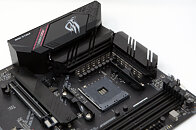If that is the case then an old CPU with a current GPU should be tested.
Consider this a 2080Ti on averages only bottlenecks 6-9% at 1080 to 4K at x4 link speed while x8 is 2-3%. Where this could actually really help a fair bit is for integrated graphics at lower resolutions. It would actually also help mGPU since they split PCIE lanes on a x16 slot into two x8/x8 configurations on the motherboard I think in 3-way and QUAD SLI/CF the gains on scaling in those configurations might be decent even if you enabled SAM support on those setups. It's really something that would be great to investigated. Think about that for a moment if mGPU setups and scaling could be tangibly improved through the use of SAM support. Going from a MMIO size of 256MB to 4GB is huge in the context of mGPU you could have in theory the equivalent of 16 card mGPU setup with the same aperture MMIO bandwidth and I/O pretty significant to me. That said weaker GPU's aren't too PCIE bottlenecked even at x4 link speed and x8 link speeds on PCIE 3.0, but still it could amount to a night and day difference in the 0.1% and 1% FPS averages and micro stutter especially in tandem with faster M.2 storage the also helps in that area.
Another aspect with mGPU and DX12 could it be leveraged with this to have each GPU to stripe data to VRAM across them? I feel like mGPU could be better with data striping VRAM and GPU processing potentially think lucid hydra type approach. I really feel they were onto something in concept, but it never quite materialized for consumers. To me I see a huge potential on data stripe parity VRAM across multiple GPU's with DX12 because it can pool the VRAM resources from what I recall. I don't know if it can do data parity VRAM allocation across them though it would be enormous with SAM and the increased aperture BAR size across multiple PCIE slots and GPU's!!? Something else as well the way Radeon Boost functions it plays right into SAM's strengths. This really could impact the landscape of mGPU with VRAM allocation data parity across numerous cards and PCIE buses like RAID-5 for the GPU's BAR size basically and with dynamic variable resolution in the case of Radeon Boost that helps make heavier usage out of SAM.
In theory with the data parity across 4 GPU's with interlacing and MFAA you could render it all at the same speed as a single 1 frame, but actually be rendering 4 separate frames across 4 different GPU's and utilizing the resources striped across each. The interlacing wouldn't be as ideal on resolution clarity, but the temporal rendering from MFAA could possibly lessen the impact of it plus spreading it across 4 frames would reduce some of the shimmer negatives of interlacing at the same refresh rates and MFAA itself reduces shimmer as well so a win/win you end up with 4 GPU's doing the work and at 1/4 the resource overhead of MSAA with progressive scan by using interlacing and MFAA.
Enabling it in the BIOS doesnt mean a lot, and Asus are pretty well known for BIOS settings that do nothing
even now i have duplicates for a bunch of BIOS settings - and they often dont even match up (i have two "AMD overclocking" sections and they dont sync settings on my B450 and x570 asus boards)
Also doesnt the GPU need to support it in the drivers for it to actually enable? So he'd need a 6800 or 6900 card?
If I'm not mistaken you can define that right in the INF file itself or in the windows registry. I think the BIOS firmware support is the real hurdle it's getting MB makers to adopt and enable it to be used in the first place. Until the MB makers enable support for it the GPU makers certainly can't enable support.
AMDs attempts to market this as a ryzen 5000 exclusive feature are dangerous. They are slowly evolving into the money grubbing caricature people love to tout with Nvidia and Intel. I am hoping the latter can become competitive once more to ensure we as consumers are protected
They are, but do you blame them for following in their footsteps with the examples they set and used weren't a positive thing for AMD nor consumers that suffered in the same manner!!? What goes around comes around correct? I'm not saying it's great for consumers, but I at least see AMD's perspective they kind of took advantage of a situation a bit in the same manner the others have in the past. It's no more a problem that AMD did it than if it had been Intel or Nvidia and looking at objectively it's hard to fault them doing in turn to them to their competitors what's been done to them in these situations leveraging a perk they were able to discover to exploit and manipulate so to speak. It's how the corporate world operates unfortunately for us consumers. Bottom line though AMD kick started the push for SAM support to the benefit of every much like they did with Mantle and it's influence on DX12 and other things along the way.







 plzkthxbye
plzkthxbye